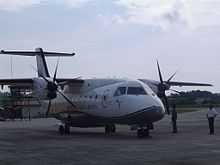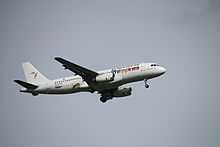Tigerair Philippines
 | ||||
| ||||
| Founded | 1995 (as SEAir Inc) | |||
|---|---|---|---|---|
| Hubs | ||||
| Fleet size | 5 | |||
| Destinations | 11 | |||
| Parent company |
Tiger Airways Cebu Pacific | |||
| Headquarters | 2nd Floor La’O Centre, Arnaiz Ave., Makati City, Philippines 1200 | |||
| Key people |
| |||
| Website | http://www.tigerair.com | |||
Tigerair Philippines, formerly known as SEAir and South East Asian Airlines, is a low-cost airline headquartered in Manila, Philippines. It is a franchise and subsidiary of JG Summit, the parent company of Cebu Pacific which operates the airline. Its main base has been transferred from Clark International Airport (formerly Diosdado Macapagal International Airport), Angeles to Ninoy Aquino International Airport, Metro Manila.
History
The airline was established as SEAir Inc, in 1995 and started operations on the same year. Its franchise however, was granted by Congress of the Philippines only on May 13, 2009 through Republic Act No. 9517.
The airline received its corporate registration with the Securities and Exchange Commission on 25 March 1995 mainly to operate aircraft leasing, chartering and few domestic scheduled flights. In May 1995, the airline was registered with the Clark Special Economic Zone to operate services in the Clark-Manila-Subic area and to tourist destinations throughout Luzon and the Visayas regions. It has had continual route expansion and opened a hub in Zamboanga City in 2002.
Seair was 60% owned by local investors: 25% by Inocentes, 23% by Olivares, 11% by Triple Star Group Holdings, Inc. and 1% by Lopez. Foreign investment at 10% by Nikos Gitsis and Iren Dornier at 30%. Iren Dornier is a German pilot and entrepreneur, the grandson of German flying pioneer Claudius Dornier.

On 29 September 2006, a deal was announced in which Singapore-based Tigerair would enter a commercial and operational tie-up with SEAIR from February 2007, involving the leasing of two planes in Tigerair colours to SEAIR, who will operate the Tigerair' planes with SEAIR's pilots and crew, but will be marketed and sold via Tigerair website. The deal does not include shareholding transactions.[1] The tie-up was finally approved in 2008 after protest from four other Philippine airlines. However, due to the unfavorable operating environment, the plan was put into hiatus. Tigerair and SEAir revisited the partnership plan in 2010 and it was officially launched on 16 December 2010.
On March, 2008, SEAIR competitor Asian Spirit was sold for around 1 billion Philippine pesos.[2] Juice king (owner of Zest-o juices) and banker Alfredo M. Yao completed the takeover of flag carrier Asian Spirit Inc. (ASI), and has shown interest in a merger with SEAIR, where Asian Spirit and SEAIR merge operations under one company and one airline.[3] The New Owners of Asian Spirit, famous for its beverage products under the Zesto group, is apparently eying for a majority 60 percent stake in SEAIR.[4]
On 16 December 2010, Tigerair entered the Philippines market by proxy, without setting up an airline in Philippines. Instead, Tigerair went into partnership with SEAir, whereby Tigerair will lease aircraft to SEAir, and SEAir will operate the aircraft in SEAir's livery, using SEAir's pilot and cabin crew. Seats on the flight operated by SEAir using aircraft leased from Tiger will be sold and marketed by Tiger for SEAir. Shortly after SEAir and Tigerair launch the partnership, Philippine Airlines, Cebu Pacific, Zest Airways, and Air Philippines sent a letter of protest to the Department of Transportation and Communications claiming the partnership between SEAir and Tigerair was illegal and requested the authorities to stop flights operating under the partnership.[5] The Tigerair-SEAir Partnership began with international flights from Clark to Singapore, Hong Kong, and Macau. It was then expanded to domestic destination from Manila (NAIA) to Davao and Cebu (slated to launch in July 2011). However, the Civil Aeronautics Board (CAB) ordered the sales of the domestic flight under the partnership to be suspended on 20 May 2011, after receiving complaints from Philippine Airlines and Cebu Pacific. Since the ban from CAB was lifted in October 2011, the planned domestic flight (between Manila(NAIA) to Davao and Cebu) was scheduled to start in May 2012.[6]
In February 2011, Tiger Airways Holdings Ltd, parent of Tigerair, purchased 32.5% shares of SEAir Inc. They increased the shares to 40% in August 2012.
In December 2012, CAB approved SEAir's application to form SEAir International. SEAir-I will fly domestic and long-haul international route. It will be a full-service airline focusing on leisure destinations. Seair-I is an independent operation from Seair Inc. which has now rebranded as "Tigerair Philippines". "The two carriers have some common shareholders but it is not a unit of the other. Seair-I was formed to take on the turboprop division [of Seair Inc.] which was excluded in the share sale with Tigerair."[7]
Founded in 1995 as SEAir or South East Asian Airlines, it became Tigerair Philippines after the Singapore-based low-cost carrier Tigerair acquired a 40% ownership share. Following approval from the Civil Aviation Authority of the Philippines, SEAir Inc was renamed "Tigerair Philippines" on 7 June 2013.
In January 2014, Cebu Pacific Air announced that it was acquiring the entirety of Tigerair Philippines for US$14.5 million by buying all shares.[8] The airline will continue to operate as "Tigerair" for some time but will eventually be fully merged into Cebu Pacific's operations.[8]
Destinations
Tigerair Philippines domestic destinations includes Manila, Clark, Cebu, Puerto Princesa, Davao, General Santos, Iloilo, Kalibo, Cagayan de Oro, Bacolod, Tacloban and Tagbilaran. International routes includes Manado, Hong Kong, Singapore from Clark.
Fleet

As of February 2015, Tigerair Philippines fleet includes the following aircraft:[9]
| Aircraft | Total | Orders | Notes |
|---|---|---|---|
| Airbus A320-200 | 5 | — | All painted in Cebu Pacific livery |
Former fleet (including South East Asian Airlines and SEAir):[10]
| Aircraft | Total | Notes |
|---|---|---|
| Dornier 328-110 | 1 | Retired in 2012 |
| Let L-410UVP-E Turbolet | 2 | |
| Aircraft | Total |
|---|---|
| Dornier 328 | 2 |
| Boeing 737-700 (Cargo) | 2 |
Incidents and accidents
- On August 26, 2013, Flight DG 8802, an Airbus A320-200 bound for Singapore, with 50 passengers on board went off the runway while making a U-turn at the Kalibo International Airport while preparing to take off.[11]
EU aviation blacklist
Tigerair Philippines is currently banned from operating in European airspace,[12][13] appearing on a list of carriers that do not meet necessary safety standards to fly to airports in the European Union.
References
- ↑ Channel News Asia
- ↑ Asian Spirit sold for around P1B
- ↑ SEAIR, Asian Spirit merger looms
- ↑ Yao Group to acquire Asian Spirit
- ↑ Airlines hit SEAir, Tiger Airways partnership
- ↑ http://www.bworldonline.com/content.php?section=Corporate&title=Seair-readies-new-routes-with-ban-lifted&id=45728
- ↑ Seair International cleared for takeoff
- ↑ 8.0 8.1 Dennis, William (January 8, 2014). "Cebu Pacific To Acquire Tigerair Philippines". Aviation International News. Retrieved 9 January 2014.
- ↑ Planespotters.net Fleet detail
- ↑ rzjets Operator page
- ↑ Article on incident
- ↑ http://ec.europa.eu/transport/modes/air/safety/air-ban/index_en.htm
- ↑ http://ec.europa.eu/transport/modes/air/safety/air-ban/doc/list_en.pdf
External links
| Wikimedia Commons has media related to South East Asian Airlines. |
| ||||||||||||||||||||||||||||||||||
| ||||||||||||||||||||||